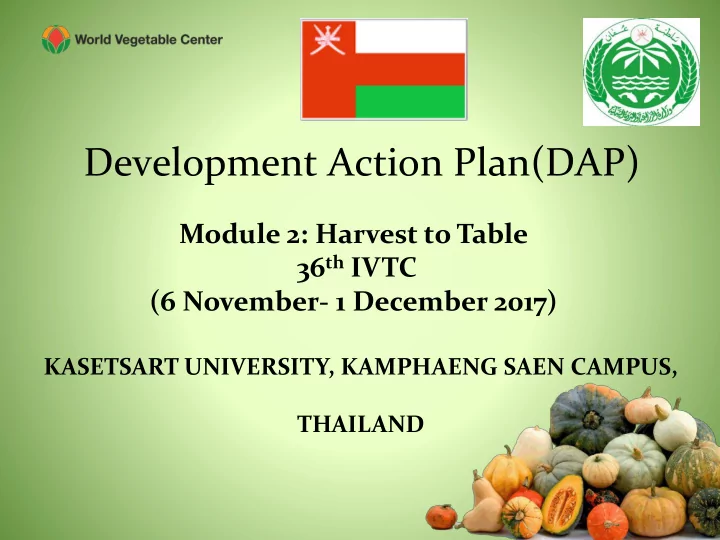

Development Action Plan(DAP) Module 2: Harvest to Table 36 th IVTC (6 November- 1 December 2017) KASETSART UNIVERSITY, KAMPHAENG SAEN CAMPUS, THAILAND
Introduction Name: Basim Bashir Bait Abaidoun. Vegetable researcher. Directorate General of Agriculture & Livestock Research. (Department of Agricultural and Animal Research). Agriculture research station – Salalah(south of Oman). Education background BSc Plant Science (Sultan Qaboos University) – Oman. MSc Organic Farming System (Newcastle University) – UK.
Main Responsibilities Evaluate and screening of new verities of vegetable crops under Salalah condition. Introduce of new technologies for high yield production (hydroponic system). Contribute to the development of research programs to increase the productivity of vegetable crops under climatic conditions. Cooperate with agricultural extension department to solve farmers' problems.
Sultanate of Oman
His majesty sultan qaboos
Country in Southwest Asia. Capital: Muscat. Population: 4.345 million according to 2014 estimates. Total area of about 309,500 sq. km. ➢ Mountains: 16%. ➢ Deserts: 81%. ➢ Coastal plains: 3%. The average annual rainfall : 100 mm. ➢ Dhofar region (south of Oman) where there is monsoon rainfall (200-250 mm) during kharif (July- September) period. Official Language: Arabic language. Religion: Islam. Weather: Hot and humid in summer and moderate in winter.
Oman has more than 2.3 million hectares of arable land .The total cultivated area is about 73,670 hectares (MoA, 2009) of which 60% is located in the coastal areas (MAF, 2009a). Area of different groups of crops in Oman (MAF, 2009) crops Area (ha) Geographical Regions of Oman Fruit Crops Perennial f Field Crops Vegetables 6185.71 Total 73671
Directorate General of Agriculture & Livestock Research(Oman) Established in March 2006
Organization and Structure 1. Plant Production Research 2. Plant Protection Research 3 .Soil Research Center Center Center - Soil Research Lab - Fruit Research Lab - Plant Pathology Research Lab - Bio-saline Research Lab - Vegetable Research Lab - Entomology Research Lab - Irrigation Research Lab - Field crops Research Lab - Biological Control Research Lab - Seed and Plant Genetic Resources - Toxicology Research Lab Research Lab - Honey bee Research Lab 4. Date palm Research Center 5. Livestock Production Research 6. The Veterinary Health Research - Date palm Production and Genetic Center Center Resources Research Lab - Goats and Sheep Research Lab - Virology Lab - Tissue culture and Biotechnology - Poultry Research Lab - Bacteriology Lab Research Lab - Cows Research Lab - Parasitological Diseases Lab - Date palm Horticulture Research Lab - Artificial Insemination Research Lab - Biochemistry and Toxicology Lab - Food Processing Research Lab - Livestock Feeding Research Lab - Pathology Lab Status Includes 126 Omani Researchers and about 460 personnel in the administrative section.
Three topics in module 2 that I found most useful. ➢ Packaging: package design , materials. ➢ Cooling: room cooling, forced air cooling, hydro cooling. and ice cooling. ➢ Rooftop organic gardening.
Action plan topic pesticides residue in fruits & vegetables
Pesticides are chemical compounds that are used to kill pests, including insects, rodents, fungi and unwanted plants (weeds).In the other hands pesticides are potentially toxic to other organisms, including humans.
Problem: High residue levels of pesticides found in some fruits and vegetables in Oman. Objective of this study ▪ Reduce the use of pesticides. ▪ Awareness from extensive use of pesticides. ▪ Determination of vegetables and fruits with residues of pesticides and their sources of entry.
Inputs: Budget. Stuff. Farmers. Experts people. Construction. Materials.
Activities : Determine the target locations. - Border gates, airports, sea ports, farms, central markets fruits and vegetables shops. Training of the agricultural extension agents. Develop of training materials (Pesticide Residue Test Kit). Farmers training in Optimal use of pesticides (how and when). Workshops. Field work. Duration: At least 1 year.
Budget Details Cost ($) Contract Worker 320,000 Travel & Transportation 200,000 Materials 120,000 Construction 1000000 Modifications& repair 40,000 Total 1,680,000
Benefits / outcomes Awareness about the extensive use of pesticides. Change of control methods for pests & diseases. Actual use of knowledge about nutrition and health. Ensure that agricultural products containing a high percentage of pesticides are not entered. Impact Improve health. Increase income. Improve social status.
Solutions: Establishment of controlled collecting centers for fruit and vegetables. Establish of packing and packaging houses. Establish of toxicology laboratories.
Challenges Budget. Most of the farmers are foreigners.
THANK YOU
Recommend
More recommend